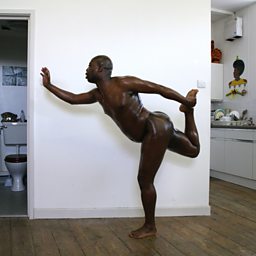Four artworks that explore what it meant to be Black and British in the 1980s
The story of the British Black Arts movement is a fascinating one, steeped in the cultural values of modern Britain.
As Free Thinking explores how the politics and social changes of the 1980s helped create a British Black Art movement, these four images reflect the culture of the time.
1. Eddie Chambers, Destruction of the National Front (1979-80)

Eddie Chambers created Destruction of the National Front when he was 20.
Looking back on the work now, he says:
Growing up in Wolverhampton I was very aware of the National Front. Their stickers were everywhere – lamp posts, phone boxes, post boxes. The Anti Nazi League was very active at the time, with posters and images. The work very much chimed with that kind of aesthetic.
Destruction of the National Front was first exhibited as part of a group show in 1981 called Black Art An'Done:
This was at a time when young black people in Britain were taking inspiration from a wide range of international as well as local issues. The anti-apartheid struggle and the murder of Steve Biko was something we identified with. We came of age in this very intense moment. The exhibition coincided with riots in Brixton in 1981. We had a charged context in which to work. These were the moments of high drama in the emergence of black Britain.
2. Sonia Boyce, From Tarzan to Rambo (1987)

Created in 1987, Sonia Boyce’s photo-based work critiques Hollywood stigmas of the white and black man through the figure of Tarzan.
She says:
This work was looking at Hollywood cinema and very particular tropes of the black subject and the figure of Tarzan: Tarzan being this heroic white male who understands the terrain better than those who have lived there for generations. He comes in and has a certain kind of mastery. I was looking at the filmic portrayal of race relations and trying to deconstruct them.
I was part of that 80s moment where it was very much DIY, do-it-yourself; come together, don’t wait for things to happen, get up and do something and do something with others. I was very much part of the cultural activism, whether it was working with women or other black artists. The term “Black” itself was about African and Asian artists coming together.
The full title of this piece - From Tarzan to Rambo, English Born ‘Native’ Considers her Relationship to the Constructed/Self Image and her Roots in Reconstruction, 1987 - must surely be a contender for the longest ever title of an artwork.
Listen to Sonia discuss her career and other examples of her work.
3. Harold Offeh, Covers: After Grace Jones, Island Life, 1985 (Graceful Arabesque) (2008)

A child of the 1980s, Harold Offeh discovered the Grace Jones album cover Island Life in his mother’s record collection. The singer and the record cover made a strong impression on him.
He says:
Grace Jones as a figure has been ever present in my consciousness. I was particularly intrigued by the history of that image which was shot by her partner Jean-Paul Goude and their close collaboration. That image is a composite image, shot from different angles, spliced and airbrushed together. What you see is believable one level, and also a fallacy.
In 2008 he went on to recreate the work as part of Covers, a series of performances in which he recreates music album images from the 70s and 80s.
What I do is very straight, rather pathetic. All the Covers are about failure.I recreate the image in my bathroom, trying to hold that position for the length of Slave to the Rhythm which is six minutes, but only being able to do a minute after which I collapse.
Listen to his fascinating story around his “playful but pathetic homage” to Grace Jones.
4. Lubaina Himid, A Fashionable Marriage, 1986

Lubaina Himid’s A Fashionable Marriage, an installation made in 1986 inspired by Hogarth’s Marriage A-la-Mode, reflects the politics of the time.
Speaking in the Art Newspaper about the work she says:
I was full of hope and looking for a fight. It presents a very particular way of talking about the history of why black people are here and also about the circumstances in which we found ourselves in the 1980s. Conversations between Ronald Reagan and Margaret Thatcher were going on at the same time as those between feminist artists and critics, who were negotiating and trying to maintain some kind of dignity across all those tumultuous scenarios. There were black political activities going on in the streets, and in the art world we were trying to decide whether calling ourselves black artists was sensible because it drew attention, or alienating because it flagged up the work as political rather than considering it as art.
Himid was one of the first artists involved in the Black Art movement and was instrumental in its development.
Artist Sonia Boyce talks about her impact:
She was very much about bringing what was quite urgent energy together in a series of shows. They created a huge buzz where artists were meeting each other for the first itme, we were getting to understand each others’ practices. There was a lot of the urgent and young energy which was vital and attracted people to become part of it.
Lubiana Himid currently has shows in Bristol and Oxford:
Navigation Charts, Spike Island, Bristol, 20 January-26 March
Invisible Strategies, Modern Art Oxford, 21 January-30 April




